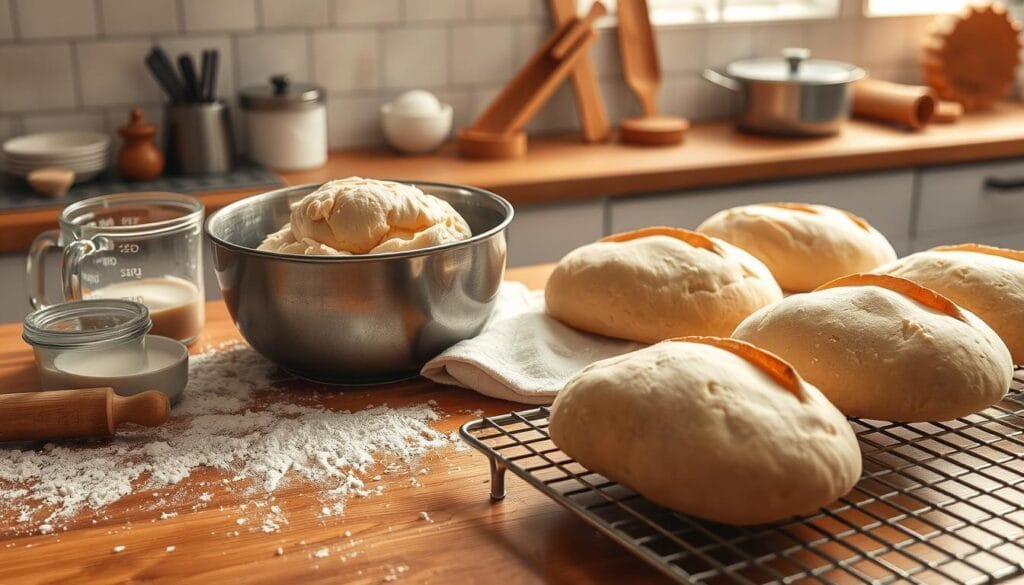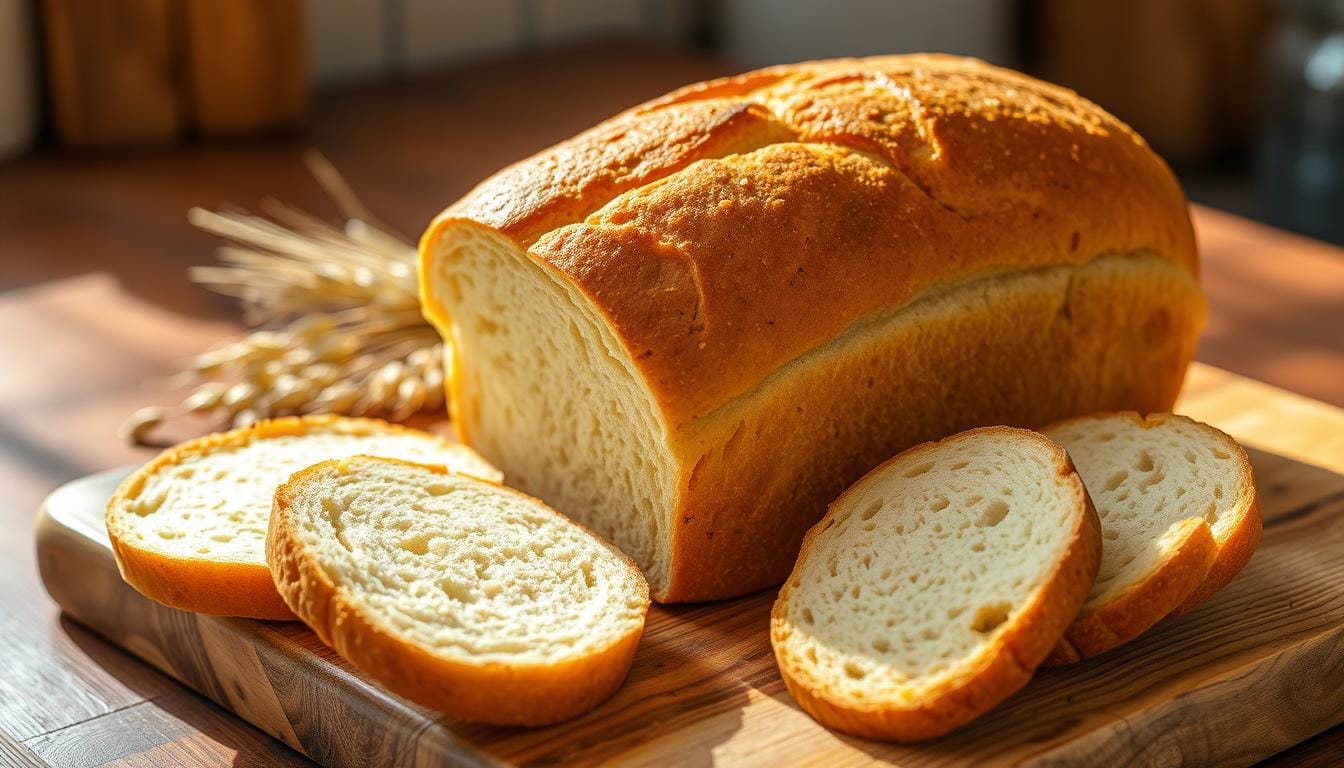Easy Homemade Sandwich Bread Recipe for Beginners
The smell of fresh bread in the kitchen is amazing. It brings back happy memories from childhood. Making homemade sandwich bread was a special treat for me. Now, I’m excited to teach you how to make it too.
This simple recipe is great for beginners. It needs just a few ingredients and easy steps. In about 3 hours, you’ll have two golden loaves of white bread. You can use it for sandwiches, toast, or anything else you like.
Table of Contents
Introduction to Homemade Bread Making
Starting your homemade bread making journey is incredibly rewarding. You’ll love the smell of fresh bread and the unique taste and texture. Making your own homemade bread brings many benefits that can make your cooking better.
Benefits of Making Bread at Home
- Full control over ingredients, ensuring your bread is free from preservatives and additives
- Cost-effectiveness compared to store-bought artisan bread
- The pride and satisfaction of creating something from scratch
- Customization opportunities to experiment with flavors and textures
- The ability to cater to dietary preferences or restrictions
Essential Kitchen Equipment Needed
To start your bread making basics, you’ll need some key tools. A good stand mixer with a dough hook makes kneading easier. Sturdy loaf pans help your bread keep its shape while baking. A bench scraper is great for cutting, shaping, and handling the dough.
Understanding Basic Bread Terms
Learning basic bread terms is important for success. Terms like “proofing” and “kneading” are key. Understanding fermentation helps achieve the perfect crumb. These concepts are crucial for your homemade bread journey.
“Baking bread is one of those almost hypnotic businesses, like a dance from some ancient ceremony. It leaves you filled with a sense of accomplishment.”
– Judith Jones, author and editor
Simple Ingredients for Perfect Sandwich Bread
Making homemade sandwich bread is easy. You just need a few simple ingredients. These include unbleached all-purpose flour, active dry yeast, and granulated sugar. You also need warm water, kosher salt, and melted unsalted butter.
For a vegan option, use avocado oil instead of butter. Make sure the water is between 85-90°F. This temperature is key for the yeast to activate and make the bread rise.
Using European butter, like Kerrygold, is best. It has more fat, making the bread softer.
- Unbleached all-purpose flour
- Active dry yeast
- Granulated sugar
- Warm water (85-90°F)
- Kosher salt
- Melted unsalted butter (or avocado oil for vegan)
These basic, quality bread ingredients are the base for tasty, homemade yeast breads made with all-purpose flour. With a few simple steps, you can make soft, fluffy sandwich bread at home.

Step-by-Step Sandwich Bread Recipe
Making homemade sandwich bread is very rewarding. You get to choose what goes into it and make a fresh loaf. The process includes mixing, kneading, shaping, and baking. Let’s explore this simple sandwich bread recipe step by step.
Mixing and Kneading Techniques
First, you need to activate the yeast. This recipe uses instant yeast, so you don’t need to proof it in water. Just mix the yeast with warm water, about 90-95°F, and wait a few minutes until it gets foamy.
Then, mix the flour, sugar, and salt in a big bowl. Add the yeast mixture and melted butter or oil. Use a stand mixer with a dough hook or knead by hand for 3-4 minutes. Proper kneading is key for the right texture in the bread.
First Rise and Proofing Process
After kneading, put the dough in a greased bowl, cover it, and let it rise for about 1 hour. It should double in size. This step lets the yeast make the dough soft and fluffy.
Shaping and Second Rise
After the first rise, punch down the dough to get rid of air bubbles. Split it in half and shape each half into a loaf. Put them in greased pans, cover, and let them rise for 45-60 minutes. They should be about 1/2-inch above the pan rim.

The second rise is important for the right texture and rise. Be patient and let the dough proof fully before baking.
Mastering the Baking Process
Baking homemade sandwich bread is a fun and rewarding task. It lets you choose the ingredients and make a better loaf than store-bought ones. To get it right, follow these key steps:
- Preheat your oven to 375°F (190°C). This temperature is perfect for a golden crust and soft inside.
- Bake the loaves for 25-30 minutes, flipping the pans halfway. This helps them brown evenly and prevents burning.
- The bread is done when it’s golden and has an internal temperature of 195°-200°F (91°-93°C). This means the starches are cooked and the yeast has done its job.
- Let the loaves cool in the pan for 5 minutes after baking. This makes them easier to remove without losing shape.
- Then, move the loaves to a wire rack to cool completely before slicing. This step is key for a soft texture and prevents the bread from becoming soggy.
Getting the baking process right is key to making perfect homemade sandwich bread. By following these steps, you’ll get a loaf with a crispy crust and a soft inside. This is the perfect base for tasty sandwiches.
| Kitchen Tool | Average Price |
|---|---|
| Oxo Stainless Steel Food Scale | $56 |
| Kenwood 5-Quart Chef Titanium Kitchen Machine | $550 |
| Original Danish Dough Whisk | $14 |
| Oxo Bench Scraper | $12 – $13 |
Using the right kitchen tools, like a food scale, stand mixer, and dough whisk, can really improve your homemade baking bread. These tools help with measuring, kneading, and shaping. This leads to better bread crust results.
“Mastering dough fermentation is pivotal for achieving light and tasty homemade sandwich bread, with optimal rising temperatures recommended between 100°F and 110°F.”
– Modernist Bread at Home
The oven temperature and dough fermentation are key to baking perfect homemade sandwich bread. By following these tips and using the right tools, you’ll make a delicious loaf every time.
Tips for Achieving Soft, Fluffy Texture
Making the perfect homemade sandwich bread is all about a few key steps. Pay attention to temperature, moisture, and cooling to get that soft bread texture. This way, your fresh-baked loaf will always turn out right.
Temperature Control
Keeping the dough at the right temperature is key for a soft, light crumb. Proof your dough in a warm, humid spot, like a preheated oven. This helps the yeast work and keeps the bread moisture in.
Moisture Management
How much flour you use while kneading matters a lot for the soft bread texture. Add flour little by little to avoid stickiness. This keeps the dough soft and easy to work with.
Proper Cooling Methods
Let your bread cool completely before slicing to avoid a soggy texture. Waiting patiently is important for that perfect soft, fluffy crumb.
By following these tips, you’ll make a homemade sandwich bread that’s irresistibly soft and fluffy. Your family and friends will love it.
Common Mistakes to Avoid
Baking homemade bread can be very rewarding. But, it’s key to avoid common mistakes. One big mistake is using old yeast. Old yeast makes bread dense and flat. Always check the yeast’s expiration date and test it in warm water before using.
Another mistake is over-kneading the dough. Kneading is good for making bread soft and fluffy. But, too much kneading makes bread tough. Stop kneading when the dough is smooth and elastic. Also, don’t cut into the bread right after it comes out of the oven. Let it cool completely for the best bread consistency.
Getting the ingredient measurements right is also crucial. Guessing can mess up the balance, making the dough too dry or sticky. Always use measuring cups and spoons to get the right amounts.
- Check yeast freshness before use to ensure proper yeast activation
- Knead dough only until smooth and elastic, avoiding over-kneading
- Let the bread cool completely before slicing for the best bread making results
- Measure ingredients accurately to maintain the correct dough consistency
By avoiding these common bread making errors, you’ll make delicious homemade bread every time.
Storage and Freshness Tips
Keeping your homemade sandwich bread fresh is key to enjoying your baking. Simple storage and reheating tips can make your bread last for days. Follow these steps to keep your bread soft and delicious.
Room Temperature Storage
For a few days, keep your bread at room temperature. Use an airtight container or resealable bag. This keeps the bread soft and moist. Don’t refrigerate it, as cold air can make it stale faster.
Freezing Instructions
Freezing is best for longer storage. You can freeze the whole loaf or just the slices. Wrap it well in plastic or use a freezer-safe bag. Frozen bread stays fresh for up to 3 months. Just thaw it at room temperature when you’re ready.
Reheating Methods
To make frozen or stale bread fresh again, try reheating. Preheat your oven to 325°F. Place the bread on the rack for 20-30 minutes. It will be warm and crisp. Or, toast slices to get that fresh-baked taste and texture.
Learning these bread storage, freezing bread, and reheating bread tricks will let you enjoy your homemade bread for days. Every slice will be as tasty as the first.
Recipe Variations and Adaptations
The Easy Homemade Sandwich Bread recipe is super versatile. You can add your favorite ingredients to make different breads. Try cinnamon and raisins for a tasty cinnamon raisin bread. Or, mix in some whole wheat flour for a nuttier sandwich bread.
Want to add more texture and flavor? Seeds, nuts, or dried fruits are great additions. The options are endless, letting you make bread that’s just right for you. Just remember, whole grain flours might need a bit more liquid.
Whether you like a traditional sandwich loaf or something new, this recipe is a great starting point. It lets you create your own unique homemade bread. So, go ahead and try new things. You’ll find bread recipes that everyone will love.
FAQ
What are the benefits of making homemade sandwich bread?
What essential kitchen equipment is needed for this recipe?
What are some key bread making terms I should understand?
What are the main ingredients used in this sandwich bread recipe?
How do I properly knead and proof the dough for this recipe?
How do I know when the bread is fully baked?
How can I ensure a soft and fluffy sandwich bread texture?
What common mistakes should I avoid when making this bread?
How should I store this homemade sandwich bread?
Can I make variations or adaptations to this recipe?
Source Links
- Homemade Soft Sandwich Bread – Lion’s Bread – https://www.lionsbread.com/perfect-soft-sandwich-bread-recipe/
- Easy White Sandwich Bread – https://thebusybaker.ca/easy-white-sandwich-bread/
- Sandwich Bread – https://baranbakery.com/sandwich-bread/
- Simply Sandwich Bread (Recipe + Video) – Sally’s Baking Addiction – https://sallysbakingaddiction.com/sandwich-bread/comment-page-32/
- Soft White Sandwich Bread – I Cook And Paint – https://icookandpaint.com/soft-white-sandwich-bread/
- World’s Fastest Sandwich Bread – https://www.thelifejolie.com/easy-bread-recipe/
- Easy Sandwich Bread (Baking Bread For Beginners ) – Savas Kitchen – https://savaskitchen.com/easy-sandwich-bread-baking-bread-for-beginners/
- Country White Sandwich Bread, Best White Bread I Baker Bettie – https://bakerbettie.com/country-white-bread/
- Easy Soft Sandwich Bread in a Loaf Pan (For Beginners) – https://thepracticalkitchen.com/soft-sandwich-bread/
- Classic Sandwich Bread – https://www.kingarthurbaking.com/recipes/classic-sandwich-bread-recipe
- Best Homemade Sandwich Bread Recipe for Beginners – https://www.bakingmagicrecipes.com/best-homemade-sandwich-bread-recipe/
- No-Knead Sandwich Bread – https://www.emmafontanella.com/no-knead-sandwich-bread
- Soft and Fluffy White Bread Loaf – https://cloudykitchen.com/blog/white-bread-loaf/
- Secrets to a Softer Crust – Bread by the Hour – https://breadbythehour.com/secrets-to-a-softer-crust/
- Sandwich Bread (VIDEO) – bakecookrepeat.com – https://bakecookrepeat.com/recipe/sandwich-bread/
- Sandwich Bread Recipe – Soft, and Perfect for Any Meal 2024 – https://differentrecipes.com/homemade-sandwich-bread-recipe/
- 23 Common Bread Machine Mistakes – Bread Dad – https://breaddad.com/common-bread-machine-mistakes/
- The Best Way to Store Bread | The Perfect Loaf – https://www.theperfectloaf.com/the-best-way-to-store-bread/
- Soft and Fluffy Sandwich Bread Recipe: Your Guide to Perfect Homemade Loaves – https://generationacresfarm.com/soft-and-fluffy-sandwich-bread-recipe-your-guide-to-perfect-homemade-loaves/
- 50+ Dishes You Can Make with Sandwich Bread – https://www.tasteofhome.com/collection/recipes-using-bread-sandwich/?srsltid=AfmBOopC39WlOtMlpkSulMnRepRQ_Ltve3DK2Pttv5gWzRdjjsvJPap2
- Easy, Soft Sourdough Sandwich Bread Recipe (1 Day) – https://thatsourdoughgal.com/easy-soft-sourdough-sandwich-bread-recipe/

